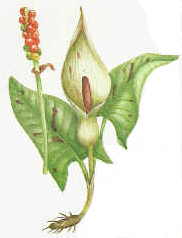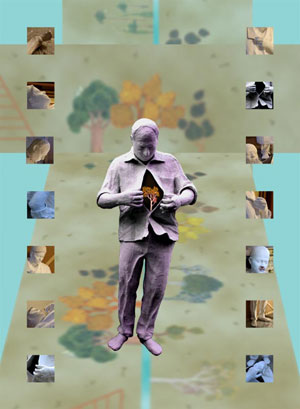Human Flower Project
Art & Media
Saturday, October 09, 2004
Lords and Ladies Ride the Irish Mail
Ireland has issued a new set of stamps featuring the lowly dandilion and the snazzy Lords and Ladies lily, Arum maculatum, pictured below.
 Noted botanical illustrator Susan Sex has painted six Irish wildflower stamps. All you Irish readers and travelers, please send mail!
Noted botanical illustrator Susan Sex has painted six Irish wildflower stamps. All you Irish readers and travelers, please send mail!
The new issue includes a mix of the island’s rarities and roadside weeds (more flatteringly described as “flowers of the hedgerow”): Dog – violet, Dandelion, Primrose, Hawthorn, Bluebell, Lords and ladies. A poetic press release from the An Post explains, “Ireland has a relatively mild and moist climate, making it possible to grow a wider range of garden plants than in most places in the temperate world. These native wild flowers consist of those that have grown here since before Ireland was separated from the European landmass after the last ice age and those that are capable of long distance dispersal and which arrived here in the winds.”
Since flower people tend to focus on uncommon species, take note of “lords and ladies,” which one source claimed is Ireland’s “only native lily.” Starch produced from the plant’s tubers was used both as cosmetic powder and as a stiffener for those dandy Elizabethan collars.
Friday, October 08, 2004
Iranian Artists Find Taproot in “Persian Gardens” Show

Group 30+ “Persian Garden 2004” (detail) Installation
Tehran’s Museum of Contemporary Art displays 17 famous gardens alongside new imaginary works in a seach for the Iranian spirit.
You may associate walled gardens with medieval monasteries, but the idea is far older than the good herbalist brothers of 12th century Europe, and far more Eastern too.
Last month, Tehran’s Museum of Contemporay Art opened Persian Gardens, an exhibition that explores Iran’s ancient garden tradition and that tradition’s endurance, in film,video, performance and installation pieces by contemporary Iranian artists.
Curator Faryar Javaherian writes, “The Persian garden is deeply rooted in Iran’s most ancient past and dates back to the beginning of agriculture and irrigation. The Persian garden is the elaborate product of a creative people living in a hostile environment, devising a poetic realm for sacred rituals and royal ceremonies. It is also a magnificent expression of the idea that water could be drawn from the innermost layers of the feverish desert earth, running underground for long stretches to emerge from a fountain in the middle of a garden.”
Today’s works reflect an elegiac mood. Some like Ahmad Mostafa Nadalian’s webart piece Paradise 2004 satirize the geometric formality and religiosity of the Persian garden legacy. Even the dizzying beauty of inscribed walls, the splendor of hyacinth and tulips (both natives of Iran) can’t shut out the crackle of technology and frivolity of secularism.
The show runs through November 3.
Wednesday, September 22, 2004
From Safe-Cracking to Rose-Feathering
A new Brit television show “Going Straight” sets up a group of ex-cons under the tutelage of a premiere floral designer.
Can flowers rehabilitate a criminal? “Going Straight,” a reality television show new this season in England, will test that question, or maybe it’s just a good excuse to snicker. Let’s watch a thug wire a rosebud.
Producers of the show say no. An article in the Guardian quotes the program’s executive producer, Hilary Rosen. “We wanted to look at why unemployment and reoffending are such a problem for people who have left prison,” she says. “But we wanted to do something positive – to offer people a chance to help themselves with advice and training.”
Six ex-offenders will work with floral designer Paula Pryke and a business consultant to set up a working shop by Mother’s Day, THE big day for florists in England. The show will track the difficulties ex-convicts face buckling down to an honest living and building public trust, as well as, presumably, keeping iris fresh longer than three days.
For Brits, the show can’t help but allude to “Buster” Edwards. Edwards participated in “The Great Train Robbery,” a notorious 1963 heist, when the Royal Mail Train was relieved of 2.5 million pounds. After his release from the penitentiary, Edwards quietly opened a flower shop outside the Waterloo station. As England’s “Bird Man of Alcatraz,” Edwards and his story intrigued the nation, a surreal combination of ruthless crime and delicate sensibility.
Good luck to the budding florists. Surely they know how Buster’s business ended. He was discovered hanging in his potting shed in 1994. Associates claimed that he’d been in on another string of train robberies, had come under suspicion, and couldn’t bear the idea of being locked up again.
Sunday, September 19, 2004
Bad Guys Bloom in Sayles Movie
In the new film by director John Sayles, Silver City , the old association of flowers with evil rises again.
There’s a big vase of flowers beside the dastardly preacher’s pulpit. When fictional Colordao senator Richard Pilager welcomes big-time donors to his mansion in the mountains, red roses and gerber daisies festoon the banquet table. Even the parade for El Dia de Los Muertos, Day of the Dead, with its loads of traditional marigolds, is directed by a cruel coyote who exploits and even murders immigrant workers.
John Sayles’s new movie Silver City tips us which characters are his bad guys: they’re the ones with flowers on hand. Even the wicked lobbyist, who’s snaked our hero’s girlfriend, has a big basket of red chrysanthemums on his front porch.
As anthropologist Jack Goody discusses in his magnum opus The Culture of Flowers , flowers have been associated with depravity in many eras. After the Roman Empire fell, early Christian church leaders forbad flowers except for medicinal use. Other phases of austerity have followed. By linking flower blossoms with the black hats in his latest release, John Sayles proves that this old association is alive and well.

